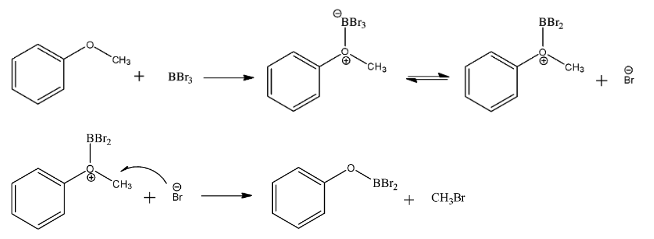
In the given reaction $PhOMe\xrightarrow[2){{H}_{2}}O]{1)BB{{r}_{3}}}\_\_\_\_\_+\_\_\_\_\_+\_\_\_\_\_$
State the products
Answer
142.2k+ views
Hint: Think about what will happen when boron tribromide reacts with an ether. After boron tribromide has caused cleavage of the ether, hydrolysis occurs and the products are formed.
Complete step by step solution:
Boron tribromide is a reagent that is used to cause the cleavage of dialkyl ether to form an alcohol, boric acid and alkyl bromide. This is a two-step reaction and requires boron tribromide in the first step and hydrolysis with water in the second step. The reaction mechanism is as follows:
i) One mole of phenyl methyl ether reacts with one mole of $BB{{r}_{3}}$ to give an intermediate complex that has benzene bonded to an oxygen atom which is further bonded to boron and two bromine atoms. It also gives a mole of methyl bromide as a byproduct.

ii) This complex can only be converted to a phenol, which is the aim of the reaction, if it is hydrolyzed by three molecules of water. Two molecules of water first hydrolyze the bonds between boron and bromine, the hydrogen proton is taken by bromine and the hydroxide ion attacks the boron atom. The remaining hydrogen atom hydrolyzes the bond between oxygen and boron where boron gets the hydroxide ion and oxygen the hydrogen proton. The reaction is as follows:
\[PhOBB{{r}_{2}}+3{{H}_{2}}O\to PhOH+{{H}_{3}}B{{O}_{3}}\]
Hence, the three products that are formed after this reaction are phenol, boric acid, and methyl bromide.
Note: The products formed that we are considering here are all the products that we will find in the vessel of the reaction after both the reagents have been added. We will consider the net products obtained and not just the ones formed in only the first or the second step.
Complete step by step solution:
Boron tribromide is a reagent that is used to cause the cleavage of dialkyl ether to form an alcohol, boric acid and alkyl bromide. This is a two-step reaction and requires boron tribromide in the first step and hydrolysis with water in the second step. The reaction mechanism is as follows:
i) One mole of phenyl methyl ether reacts with one mole of $BB{{r}_{3}}$ to give an intermediate complex that has benzene bonded to an oxygen atom which is further bonded to boron and two bromine atoms. It also gives a mole of methyl bromide as a byproduct.

ii) This complex can only be converted to a phenol, which is the aim of the reaction, if it is hydrolyzed by three molecules of water. Two molecules of water first hydrolyze the bonds between boron and bromine, the hydrogen proton is taken by bromine and the hydroxide ion attacks the boron atom. The remaining hydrogen atom hydrolyzes the bond between oxygen and boron where boron gets the hydroxide ion and oxygen the hydrogen proton. The reaction is as follows:
\[PhOBB{{r}_{2}}+3{{H}_{2}}O\to PhOH+{{H}_{3}}B{{O}_{3}}\]
Hence, the three products that are formed after this reaction are phenol, boric acid, and methyl bromide.
Note: The products formed that we are considering here are all the products that we will find in the vessel of the reaction after both the reagents have been added. We will consider the net products obtained and not just the ones formed in only the first or the second step.
Recently Updated Pages
Classification of Drugs Based on Pharmacological Effect, Drug Action

Difference Between Alcohol and Phenol

JEE Main Participating Colleges 2024 - A Complete List of Top Colleges

JEE Main Maths Paper Pattern 2025 – Marking, Sections & Tips

Sign up for JEE Main 2025 Live Classes - Vedantu

JEE Main 2025 Helpline Numbers - Center Contact, Phone Number, Address

Trending doubts
JEE Main 2025 Session 2: Application Form (Out), Exam Dates (Released), Eligibility, & More

JEE Main Exam Marking Scheme: Detailed Breakdown of Marks and Negative Marking

JEE Main 2025: Derivation of Equation of Trajectory in Physics

Electric Field Due to Uniformly Charged Ring for JEE Main 2025 - Formula and Derivation

Types of Solutions

Learn About Angle Of Deviation In Prism: JEE Main Physics 2025

Other Pages
NCERT Solutions for Class 12 Chemistry Chapter 6 Haloalkanes and Haloarenes

NCERT Solutions for Class 12 Chemistry Chapter 2 Electrochemistry

NCERT Solutions for Class 12 Chemistry Chapter 7 Alcohol Phenol and Ether

NCERT Solutions for Class 12 Chemistry Chapter 1 Solutions

Solutions Class 12 Notes: CBSE Chemistry Chapter 1

JEE Advanced Marks vs Ranks 2025: Understanding Category-wise Qualifying Marks and Previous Year Cut-offs




